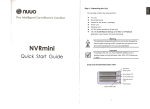Download Chiron IRIS Touch 400 Range Dialler Installation manual
Transcript
IRIS Touch 400 Range Dialler Installation Manual Version 1.4 The information contained is supplied without liability for any errors or omissions. No part may be reproduced or used except as authorised by contract or other written permission. The copyright and foregoing restriction on reproduction and use extend to all media in which the information may be embedded. © 2012 Chiron Security Communications Ltd Contents 1. Introduction ..................................................................................................1 1.1. About this manual… ...........................................................................1 1.2. Overview ............................................................................................2 1.3. System specifications .........................................................................3 2. Before you start… ........................................................................................5 2.1. Package contents ...............................................................................5 2.2. Pre-requisites .....................................................................................5 3. Alarm dialler interface ..................................................................................6 4. Installing the IRIS Touch Dialler ..................................................................7 5. Configuring the IRIS Touch Dialler ..............................................................9 6. Post installation.......................................................................................... 10 7. PIN alarms .................................................................................................10 7.1. Installation ........................................................................................ 11 7.2. Default alarm messages .................................................................. 12 8. Relay outputs ............................................................................................. 12 9. Troubleshooting ......................................................................................... 13 Appendix A – Settings menu............................................................................. 14 Appendix B – Installation photo ........................................................................ 16 Appendix C – Specification ............................................................................... 17 IRIS Touch 400 Range Dialler Installation Manual V1.4 i ii IRIS Touch 400 Range Dialler Installation Manual V1.4 1. Introduction 1.1. About this manual… This manual is designed to help you, the Installer, with the installation process for the IRIS Touch alarm dialler. We recommend that you read through this manual, in its entirety, before you visit the customer’s site and begin the installation. Please note: For fire alarm installations that must conform to European standard EN5421 please make sure the installation conforms to the requirements set out in Chiron’s installation guide “IRIS Touch Range Dialler Installation Guide for EN54-21 Compliant Fire Applications”. For installations that must conform to the requirements of the UK specific standard LPS1277 make sure the installation conforms to the requirements set out in Chiron’s installation guide “IRIS Touch Range Dialler Installation Guide for LPS 1277 Compliant Applications”. IRIS Touch 400 Range Dialler Installation Manual V1.4 1 1.2. Overview The IRIS range of alarm diallers allow users to migrate intruder alarm systems away from traditional PSTN communications to IP based and/or wireless networks, without the need to upgrade or replace the alarm system. The majority of intruder alarm systems which are configured to make alarm calls to a central monitoring station use the traditional PSTN analogue network as the communications path. However, PSTN is becoming increasingly unsuitable as users move to IP and Voice over IP (VoIP) for their fixed networks or rely purely on mobile (GSM and GPRS) communications. In addition most PSTN service providers are migrating to VoIP networks, so in the not too distant future PSTN lines may be withdrawn. The IRIS dialler range is unique in offering a quick and cost effective way to interface any existing alarm system to alternative networks such as GSM, Ethernet and GPRS. As a result of the flexibility and power of IRIS it has become the IP transmission system of choice for monitoring centres across Europe. The IRIS 400 series is intended to be used with alarm panels that have sufficient space inside their enclosures for the IRIS dialler to be fitted. There are three diallers in the range: IRIS Touch 400 - GPRS IRIS Touch 420 - Ethernet IRIS Touch 440 - Ethernet & GPRS The IRIS Touch dialler should be located within the alarm panel tamper protected enclosure and powered from the alarm panel battery backed power supply. 2 IRIS Touch 400 Range Dialler Installation Manual V1.4 1.3. System specifications Feature IRIS Touch 400 GPRS IRIS Touch 420 Ethernet Easy to install and test with touch screen interface 2-wire (POTS) analogue interface to standard alarm diallers Support for SIA (1-3), Contact ID, Scancom (Fast Format) and Robofon protocols Pin inputs for alarm messages over SMS 16 16 16 16 Relay contact outputs 4 4 4 4 9-30V DC power from alarm panel USB port for local configuration Secure polling (monitoring) over Ethernet Secure alarm transmission over Ethernet 16 16 16 Pin inputs for alarm messages over Ethernet or GPRS 16 Configuration and diagnostics over Ethernet IRIS Touch 440 Ethernet & GPRS IRIS Touch 440R Ethernet, GPRS & PSTN Secure polling (monitoring) over GPRS Secure alarm transmission over GPRS Configuration and diagnostics over GPRS IRIS Touch 400 Range Dialler Installation Manual V1.4 3 4 Alarm transmission over GSM Serial port for connection to alarm panel for fast upload/download Call confirmation ‘polling’ over PSTN Alarm transmission over PSTN Pin inputs for alarm transmission over PSTN IRIS Touch 400 Range Dialler Installation Manual V1.4 2. Before you start… 2.1. Package contents In this package you should have the following components: Main dialler PCB with four self-adhesive feet Power cable (black) for connection to DC supply. Ethernet cable (cream) for connection to IP network. (Ethernet / Ethernet & GPRS only.) Antenna for GSM/GPRS. (GSM / Ethernet & GPRS only.) Dialler cable (grey) for connection to dialler output of alarm panel. Sense resistor (18K ohm) for alarm dialler cable fault/tamper detection. Installation manual. 2.2. Pre-requisites For installations using IP (Ethernet) or GPRS you must ensure you have the following: If the installation is in a residential environment, you will need to fit inductors to the input cables of the dialler in order to ensure compliance with EMC Class B emissions requirements. Suitable inductors can be obtained from Chiron. The IP address for the monitoring centre. Confirmation that the monitoring centre is set up and ready for the account number or name to be used for this IRIS dialler. The type of IP address (either automatic or fixed) for the installation site. If the site has a fixed IP address, you should get this information from the customer in advance, together with the Gateway Address and the Subnet Mask for the IRIS dialler. An additional long Ethernet CAT5 cable, in case the installation site requires one longer than that supplied with the IRIS dialler. Cable lengths up to 100m are allowable. A SIM card enabled for GPRS with the PIN code clear. (Ethernet & GPRS only.) The GPRS Access Point Name (APN) of the SIM card provider. Some networks also require a User Name and Password which can also be obtained from the SIM card provider. (Ethernet & GPRS only.) IRIS Touch 400 Range Dialler Installation Manual V1.4 5 3. Alarm dialler interface IRIS diallers carry alarm signals from the alarm panel over IP completely transparently so when they arrive at the monitoring centre it is as though they had come over a traditional PSTN connection. IRIS diallers support SIA (Levels 1 to 3), Contact ID, Scancom (Fast Format) and Robofon protocols, one of which virtually all alarm panels will support. Apart from the following, no reconfiguration of the alarm panel is required for use with IRIS diallers: 1. If alarm signalling over Ethernet or GPRS is required, change the setting in the alarm panel for the telephone number to be dialled for alarm signalling. This number should be changed to the IP address of the monitoring centre, entered as 12 digits. Each of the four IP address numbers separated by a ‘.’ should be entered as a 3 digit number, with leading ‘0’s as required, and the ‘.’s should be excluded. For example: IP address 10.1.146.22 is entered as 010001146022. If the monitoring centre requires a backup IP address to be entered, this is done in the same way. 2. If alarm signalling over GSM is required, add a leading digit ‘7’ to the normal PSTN telephone number of the monitoring centre. 3. If the panel is required to make outgoing calls over IP for upload/download or remote configuration, then where the telephone number for this would normally be entered, put in the digit ‘8’ followed by the destination IP address in 12 digit format, as above. 6 IRIS Touch 400 Range Dialler Installation Manual V1.4 4. Installing the IRIS Touch Dialler Use the following procedure to install the IRIS Touch Dialler. Note: For installations using PIN alarm inputs see the PIN alarms section for additional information and for wiring to relay outputs see the Relay outputs section. Do not apply power to the dialler until indicated. 1. Decide where to mount the dialler and run the cables Decide the best way to mount the dialler within the alarm panel enclosure and the cables from the alarm panel to the dialler and the external connections from the dialler. 2. Mount the dialler in the alarm panel enclosure Secure the dialler within the enclosure using the self-adhesive feet. 3. Plug in the connectors Connect the relevant cables to the PCB: Ethernet cable (cream) [1] (Ethernet / Ethernet & GPRS only.) Dialler cable (grey). [2] Power cable (black). [3] 4. Install the antenna (GSM / Ethernet & GPRS only) Connect the antenna to the PCB. [4] 5. Fit the SIM card (GSM / Ethernet & GPRS only) Fit the SIM card. [5] Power must not be applied to the PCB while the SIM card is being fitted or removed or it may be damaged. IRIS Touch 400 Range Dialler Installation Manual V1.4 7 6. Plug in the external cables Plug the dialler cable into the alarm panel dialler. If the alarm panel has screw connections, cut the connector off the cable and strip the cable using the 2 inner wires. Polarity is not important. Plug the Ethernet cable into the local IP router or socket that has been allocated for the IP connection. 7. Plug in the sense resistors Fit the 18K sense resistor in parallel with the dialler output of the alarm panel, at the alarm panel end of the cable. Note: This resistor enables the IRIS dialler to detect cable faults and/or tampers and must be fitted at the alarm panel end of the cable to function correctly. 8 IRIS Touch 400 Range Dialler Installation Manual V1.4 5. Configuring the IRIS Touch Dialler The majority of configurations can be carried out via the touch screen interface display on the IRIS dialler. For more complex systems, for example where the data port is used, additional configuration is available via the USB connector using a laptop / PC and IRIS dialler configuration software (www.chironsc.com). The touch screen display on the IRIS dialler provides an Installation Wizard which guides you through a set of instructions for configuring the dialler. It is recommended that you use this Wizard as it automatically carries out tests as you proceed through the configuration. Note: To select an option on the screen, touch the screen display. Use the following procedure to configure the IRIS Touch Dialler: 1. Plug the power cable into the battery backed supply of the alarm panel. The cable with the white stripe is the –ve connection. Ensure that the display on the dialler becomes active. The dialler carries out a self test and the Welcome screen then displays. Note: If the power has been connected for the first time the Language menu displays. Select the appropriate language from the list of languages available. 2. Select the Installer Menu or Touch to configure option from the Welcome screen. It is necessary to enter a pin number, which is set by default to “111111”. It is strongly recommended that this pin number is changed from the default, which is an option available in the Settings menu. 3. Select the Installation Wizard option from the Installation Menu. 4. Follow the remaining instructions on the screen. Note: During the installation procedure the Wizard shows the GSM/GPRS signal strength. At this time the antenna position can be adjusted for optimum signal. (GSM / Ethernet & GPRS only.) Once the installation is completed successfully the message Status System OK is displayed on the Welcome screen and the LED Indicator on the PCB [6] is on steady. IRIS Touch 400 Range Dialler Installation Manual V1.4 9 Note: If the ‘Alarm Override’ mode is selected, the IRIS Touch Dialler replaces the phone number and the account number used by the alarm dialler with the IP address of the monitoring centre and Account Number entered during configuration, so there is no need to change any settings on the alarm dialler. If this is not appropriate (e.g. if the alarm dialler uses more than one account number) then the telephone number dialed by the alarm dialler should be set to the IP address of the monitoring centre in 12 digit format (e.g. 192.168.0.34 becomes 192168000034). 5. Carry out all the standard alarm signaling tests appropriate for the alarm system. 6. Replace the cover on the alarm panel enclosure. 6. Post installation If a fault should develop, then the ‘SYS’ LED indicator on the dialler will start flashing and the display will show a system fault message. This message can be touched to gain access to more information. 7. PIN alarms The IRIS Touch series have PIN inputs [7] that can be used to generate alarm messages. These can be: Text messages via SMS. (GSM / Ethernet & GPRS only.) SIA alarm messages over IP to the monitoring centre. Contact ID (CID) alarm messages over IP to the monitoring centre. Fast Format alarm messages over IP to the monitoring centre. The messages for each PIN can be configured via the Settings Menu on the touch screen display. See Appendix A for more details. 10 IRIS Touch 400 Range Dialler Installation Manual V1.4 7.1. Installation Each PIN input is designed to be connected in a loop via an open/close contact source from an alarm panel, or other device, to a reference ground PIN [8] available on the IRIS dialler, as shown below: Reference ground pins Pin inputs 1 4 Opening the contact (i.e. loop is open circuit) generates an alarm signal. Closing the contact generates the equivalent restore signal. It is also possible to link the contacts to the IRIS dialler via sense resistors so that an open or short circuit tamper on the loop can be detected and the monitoring centre alerted. In this case the connections should be made as shown below: Reference ground pins 1 Pin inputs 4 4K7 Resistor 15K Resistor Note: For this feature to work correctly it is essential that the resistors are connected at the contact end of the loop and not the dialler end and that this monitoring is enabled on the dialler, which can either be done in the Installation Wizard for all inputs in use, or for each input individually in the Settings menu. The monitoring centre must also enable the monitoring of this facility on the dialler within the IRIS receiving system. IRIS Touch 400 Range Dialler Installation Manual V1.4 11 7.2. Default alarm messages The default SIA messages for each PIN are shown below: Pin ‘Set’ message ‘Restore’ message Meaning 1 NBA01 NBR01 Burglary alarm/restore 2 NFA02 NFR02 Fire alarm/restore 3 NQA03 NQR03 Emergency alarm/restore 4 NOP04 NCL04 Open/close 5 NPA05 NPR05 Panic alarm/restore 6 NUA06 NUR06 User defined alarm/restore 7 NAT07 NAR07 Power fail/restore 8 NTA08 NTR08 Tamper/restore 9 NBA09 NBR09 Burglary alarm/restore 10 NFA10 NFR10 Fire alarm/restore 11 NQA11 NQR11 Emergency alarm/restore 12 NOP12 NCL12 Open/close 13 NPA13 NPR13 Panic alarm/restore 14 NUA14 NUR14 User defined alarm/restore 15 NAT15 NAR15 Power fail/restore 16 NTA16 NTR16 Tamper/restore 8. Relay outputs The IRIS dialler has two relay outputs [9] that can be used in a number of ways: To indicate communications path failure. Activation by incoming SMS message. Setting by the monitoring centre. The relay contacts are normally open and closed when activated. Wire to these contacts as required and define how they are to be used using the configuration options on the Settings Menu. See Appendix A for more details. 12 IRIS Touch 400 Range Dialler Installation Manual V1.4 9. Troubleshooting Problem Resolution No screen display when IRIS dialler is connected to the power. Check that there is power to the system and that the wiring is the correct polarity. A fault develops and is indicated by the LED on the PCB flashing. Touch the display and the instructions will guide you through identification of the problem. Go to the Installers menu and select Test to use the integrated test function. IRIS Touch 400 Range Dialler Installation Manual V1.4 13 Appendix A – Settings menu Setting Purpose Network Interfaces Selects which network interfaces are going to be used (i.e. Ethernet and/or Ethernet/GPRS). Stops dialler reporting trouble on interfaces not being used. Account Name/Number The IRIS account number/name, as allocated by the monitoring centre. ARC IP Address IP address of the receiver at the monitoring centre. Dialler IP Address IP address of the dialler, i.e. either automatic (DHCP) or fixed. GPRS Settings Diagnostic tools for viewing signal strength and running network scan. Setting of GPRS Access Point Name (APN), user name and password, SIM PIN, GSM Call Barring and Roaming SIM. Alarm Panel Interface Selects whether or not the 2-wire cable to the dialler is monitored for short and open circuit. Note: For monitoring to function correctly a sense resistor must be fitted as described earlier in this manual. Sets reporting of poll failure (by dropping line voltage), simulation of dial tone and cadence of incoming ring signal. Setting for use with GSM/PSTN only (i.e. no IP) operation. Setting for serial port emulations. Alarm Override If enabled, alarm panel dialled number and account number overridden by IRIS settings. Extra Features Settings for EN54-21, VdS and ILKA operation. Incoming IP Address Up to 3 source IP addresses against which incoming TCP/IP calls can be validated. There will be no validation if all 3 are clear. Pin Inputs Selects whether or not pin inputs are monitored (using sense resistors) and selects input function: Send SMS message. Send SIA, Contact ID and Fast Format alarms over IP. Trouble Reporting Selects how local communications problems are reported, via: Relay outputs. SMS. Sets IP address of support centre for remote diagnostics. Relay sma activation Activation of relay outputs by incoming SMS messages. Language Selects language. Installer Password Sets a password to the Installer menus, if required. Contrast Sets display contrast. Restore Clears tamper alarm if tamper switches have been triggered. 14 IRIS Touch 400 Range Dialler Installation Manual V1.4 Setting Purpose Dial Port Speaker The dialler has a diagnostic tool with integral speaker to allow the audio signal to and from the alarm dialler to be heard. The audio can be switched on and off. Default all Sets all settings back to factory defaults. Build Information Indicates when current software (note – not the physical hardware) was built. Reflash Allows dialler software to be updated to latest version from Chiron’s Reflash Server. IRIS Touch 400 Range Dialler Installation Manual V1.4 15 Appendix B – Installation photo [8] [7] [9] [3] [1] [2] [4] [6] 16 [5] IRIS Touch 400 Range Dialler Installation Manual V1.4 Appendix C – Specification Alarm Dialler Interface Two wire interface via RJ11 socket 40V feed at 12mA Ringing voltage 40V P-P to REN4 for incoming calls Off hook detection with dial-tone presented to alarm dialler DTMF tone recognition for dialing outgoing calls and alarm signaling Ethernet Interface 10Mbps and 100Mbps (10/100BaseT) with auto-negotiation UTP with standard RJ45 socket for CAT-5 cabling Dynamic IP addressing (DHCP) or fixed GSM/GPRS Interface Dual band GSM 900 MHz and DCS 1800 MHz SMA socket for antenna connection IP TCP ports (outbound): 10001 (remote service), 51292 (diagnostics), 53165 (alarms and polling). PIN Inputs Maximum input voltage range 0V to +24V Input ‘low’ threshold < 2V Input ‘high’ threshold > 3V Input pull-up impedance Internal 10K to 5V supply Relay Outputs Maximum operating voltage 24V DC Maximum current rating 100mA DC Power Supply Supply voltage 9 - 30V DC Ethernet only (typical current) dial capture port on hook 145mA (supply at 12v) Ethernet only (typical current) dial capture port off hook 175mA (supply ay 12V) With GSM/GPRS (typical current) dial capture port on hook 185mA (supply at 12V) With GSM/GPRS (typical current) dial capture port off hook 215mA (supply at 12V) Note: These figures are based upon the Ethernet link being connected. With GSM/GPRS there will also be additional transient peak current of up to 250mA required as GSM and GPRS transmissions (e.g. for network registration and calls) are made. Weights Dialler unit 300g Fully packaged 500g IRIS Touch 400 Range Dialler Installation Manual 17 Conformance The IRIS range of alarm diallers comply with the following European Directives: 1999/5/EC (Radio & Telecoms Terminal Equipment Directive). 2006/95/EC (Low Voltage Directive). 2004/108/EC (Electromagnetic Compatibility Directive). Conformance to EN50131 and EN50136 The IRIS diallers are compatible with the requirements of European standards EN50131-1 (Alarm Systems – Intrusion and hold-up systems Part 1: System Requirements) (dated 2006) and EN50136-1-1 (Alarm Systems – Alarm transmission systems and equipment) (January 1998 with Amendment 1 August 2001) as follows: The IRIS diallers conform to Environmental Class II. The IRIS diallers are compliant to ATS 6 compatible with Security Grade 4. Safety Care should be taken when interconnecting telecommunications equipment that only like interfaces are interconnected to avoid safety hazards. SELV: SELV (Safety Extra-Low Voltage) is defined as a secondary circuit which is so designed and protected that under normal and single fault conditions the voltage between any two accessible parts does not exceed a safe value (42.4V peak or 60V dc maximum). The interfaces on the IRIS dialler have the following safety classifications: Dialler Interface: SELV suitable for connection to the TNV interface of a single line telecommunications equipment such as telephones, faxes, etc. Data Interface: SELV suitable for connection to the SELV interface on a data terminal such as a PC COM port. Power Interface: SELV for connection to a DC supply. Inputs and Outputs: SELV for connection to alarm output and input pins. For conformance to the requirements of EN60950, the dialler must be powered from a Limited Power Source as defined in EN60950. The output of the power supply should be fused at 3.0A (slow blow). 18 IRIS Touch 400 Range Dialler Installation Manual V1.4 The future of security, secured IP by security professionals, for the professional security industry Telephone: +44 (0)118 099 0228 E: [email protected] www.chironsc.com Chiron Security Communications Ltd, Wyvols Court, Swallowfield, Reading, Berkshire, RG7 1WY UK The information contained is supplied without liability for any errors or omissions. No part may be reproduced or used except as authorised by contract or other written permission. The copyright and foregoing restriction on reproduction and use extend to all media in which the information may be embedded. © 2012 Chiron Security Communications








































